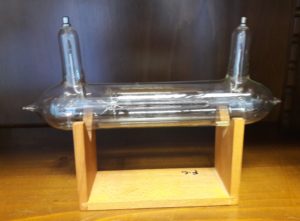
IT – Questo tubo a vuoto, inventato dal fisico inglese W. Crookes nel 1874, permette di dimostrare che i raggi catodici (elettroni) sono dotati di massa, ossia hanno natura corpuscolare. Lo strumento è costituto da un tubo di forma allungata che reca superiormente due elettrodi e poggia su un sostegno in legno. Al suo interno è posto un mulinello a palette di alluminio (in parte trattate con vernice fluorescente), in grado di scorrere orizzontalmente su due guide di vetro. Collegando gli elettrodi ad un generatore di tensione, il fascio di elettroni che parte dal catodo urta le palette del mulinello che, mettendosi a ruotare, si muove lungo il tubo, spostandosi verso l’elettrodo positivo.
GB – Crookes tube with reel – This vacuum tube, invented by the English physicist W. Crookes in 1874, allows us to demonstrate that the cathode rays (electrons) have mass, that is, they have a corpuscular nature. The instrument consists of an elongated tube with two electrodes at the top and rests on a wooden support. Inside there is an aluminium paddlewheel (or turbine), partially treated with fluorescent paint, which is able to slide horizontally on two glass guides. By connecting the electrodes to a voltage generator, the electron beam that starts from the cathode hits the vanes of the paddlewheel which, as it rotates, moves along the tube, moving towards the positive electrode.